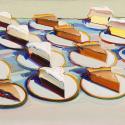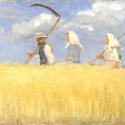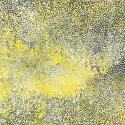David Hockney has a new toy, an app designed specially for him that allows him to work on an iPad with fine brushes. He spent the first five months of lockdown In Normandy making daily records of the coming of spring; the results are displayed in a large show at the Royal Academy (★★). Seamless animation turns his still images into a continuum. As you watch the gradual transition from bare branches to full flowering, it’s as if you were looking over the artist’s shoulder while he works, which is fascinating.
Then come the inkjet prints of the iPad pictures; they have the uncanny luminosity of the screen images, but also their flatness and lack of texture (pictured below: The Arrival of Spring, Normandy no 259, 2020). There’s no sense of space, air or atmosphere. The limited range of colours is another problem; the grass, for instance, is always bright emerald. So despite the variety of marks Hockney has at his disposal, the results are still garish approximations; better stick to black and white until the tech gets more sophisticated.
On view in the Sackler Galleries, meanwhile, are Michael Armitage’s fine paintings (★★★★). Instead of canvas, he chooses to paint on bark from the Mutuba tree which, in Kenya (where he was born) is traditionally used for burials. Once stripped from the tree, the bark is softened with mallets before being sewn into larger sheets, so his pictures are scarred with seams and punctured with holes from the heavy pounding.
Onto this uneven surface Armitage paints multi-layered images that seem to go in and out of focus. A passage of fluent realism, such as a shouting head or a bloody hand grabbing an ankle, will be juxtaposed with an area of sketchy abstraction or filmy ambiguity. You might think you’ve understood what you can see, but next minute things dissolve into uncertainty.
Take, for example, The Paradise Edict, 2019 (main picture), a tropical landscape whose diffuse colours and dreamy, hothouse atmosphere are reminiscent of a Gauguin painting. A crocodile basks in the foreground, its mouth gaping open, while behind it lush vegetation stretches to the horizon. This is the tourist brochure version of Africa; but the view is of Kiwaya, an island off the coast where regular clashes occur between Kenyan armed forces and members of the Al-Shabaab terrorist group based in nearby Somalia.
Glimpses of mayhem are woven into the fabric of this apparently untroubled Eden. A body is slung over a shoulder, while another is being dragged by the ankles; legs appear in the sky, as if their owners were ascending into heaven. Look again, and the outline of a female marathon runner comes into view, sprinting towards you.
 So take your pick: Kenya as an unspoiled tourist destination, or a country crippled by poverty, drought and conflict that, nevertheless, produces long-distance runners who conquer the world. By overlaying these disparate narratives, Armitage aims to create a portrait of the country that is more complex and more realistic. Melding the various elements into a legible whole is a remarkable feat; The Paradise Edict is a tour de force of subtle ambiguity. But while disentangling the interwoven layers, I was hampered by my scant knowledge of Kenyan culture and history. What should I make, for instance, of the three snakes emerging from a black arse?
So take your pick: Kenya as an unspoiled tourist destination, or a country crippled by poverty, drought and conflict that, nevertheless, produces long-distance runners who conquer the world. By overlaying these disparate narratives, Armitage aims to create a portrait of the country that is more complex and more realistic. Melding the various elements into a legible whole is a remarkable feat; The Paradise Edict is a tour de force of subtle ambiguity. But while disentangling the interwoven layers, I was hampered by my scant knowledge of Kenyan culture and history. What should I make, for instance, of the three snakes emerging from a black arse?
With Mydas, 2019 (pictured above left), my ignorance proved even more problematic. According to the Greek myth, King Midas died of starvation after being granted the wish that everything he touched would turn to gold. Armitage has recast Midas as a benign ruler willing to do anything for his people. The scene is set in northern Kenya, an area prone to drought and beset by political problems.
A child clings to her mother as she squats on the ground, apparently in despair. A naked man resembling Mahatma Gandhi stands in a shallow tub beside them; he is washing in what looks like a shower of blood. Silhouetted against a starlit sky on the window sill above him, a scrawny cat laps at a pool of blood. Other things lurk in the watery bands of turquoise and black that frame the figures, but I couldn’t identify them and the meaning of this intriguing picture remains obscure.
The same is true of Mkokoteny, 2019. The rickshaw man charging towards us is brilliantly observed, but why are his passengers in such a state of excitement and where are they heading? I am left admiring the incredible skill with which Armitage articulates the figures and the space around them. My goodness, this man can paint! So am I being greedy in wanting more?
The last room is dedicated to a group of Kenyan painters chosen by Michael Armitage to accompany his show while, in Kenya, he has set up the Nairobi Contemporary Art Institute to promote the work of East African artists.
- David Hockney is at the Royal Academy to September 26, Michael Armitage to September 19









![SEX MONEY RACE RELIGION [2016] by Gilbert and George. Installation shot of Gilbert & George 21ST CENTURY PICTURES Hayward Gallery](/sites/default/files/styles/thumbnail_125_x_125_/public/mastimages/Gilbert%20%26%20George_%2021ST%20CENTURY%20PICTURES.%20SEX%20MONEY%20RACE%20RELIGION%20%5B2016%5D.%20Photo_%20Mark%20Blower.%20Courtesy%20of%20the%20Gilbert%20%26%20George%20and%20the%20Hayward%20Gallery._0.jpg?itok=3oW-Y84i)





Add comment